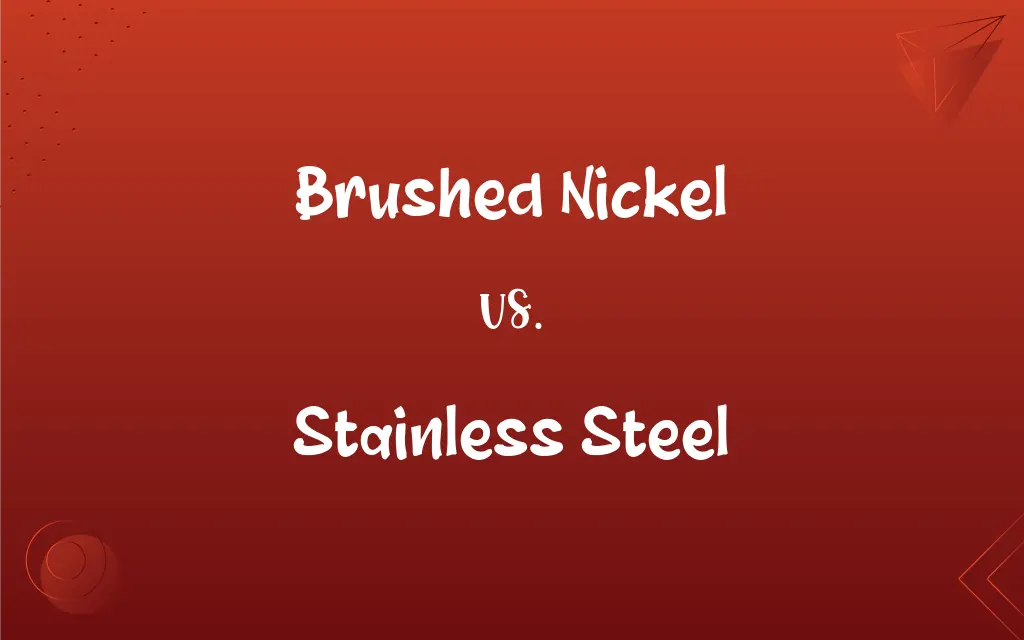Brushed Nickel vs. Stainless Steel: What's the Difference?
Edited by Janet White || By Harlon Moss || Updated on October 18, 2023
Brushed nickel is a finish applied to nickel hardware, giving it a muted luster, while stainless steel is a corrosion-resistant alloy primarily of iron with chromium.

Key Differences
Brushed nickel is a type of finish characterized by tiny brush marks creating a soft matte appearance. On the contrary, stainless steel refers to a group of iron-based alloys known for their corrosion resistance, primarily due to the inclusion of chromium.
Brushed nickel provides a warm and muted aesthetic to fixtures, making it popular in interior designs. In comparison, stainless steel boasts a shiny, modern look, and its strength and resistance make it prevalent in many applications beyond just aesthetics.
When considering durability, brushed nickel can show wear and tarnish over time, especially if not properly maintained. In contrast, stainless steel is notably durable, withstanding high temperatures, pressures, and corrosive environments.
In terms of cost, fixtures made of brushed nickel can sometimes be more expensive due to the intricate finishing process. Meanwhile, stainless steel items might vary in cost based on the grade and quality of the alloy used.
Both brushed nickel and stainless steel are popular choices in home and industrial settings. While brushed nickel is often chosen for its decorative appeal, stainless steel is commonly selected for its functional benefits and sleek appearance.
ADVERTISEMENT
Comparison Chart
Material vs. Finish
A finish applied to nickel hardware.
An alloy primarily made of iron with chromium.
Appearance
Soft matte appearance with brush marks.
Shiny, bright, and modern appearance.
Durability
Can show wear and tarnish over time.
Highly durable, resistant to corrosion, heat, and pressure.
Cost
Sometimes more expensive due to finishing.
Varies based on the alloy grade and quality.
Primary Use
Decorative purposes in interiors.
Functional and decorative, used in various applications.
ADVERTISEMENT
Brushed Nickel and Stainless Steel Definitions
Brushed Nickel
A finish applied to nickel surfaces resulting in brush marks.
The brushed nickel faucet added a touch of elegance to the bathroom.
Stainless Steel
A strong material resistant to rusting, staining, and corrosion.
She chose a stainless steel sink for its durability and sleek look.
Brushed Nickel
A muted luster finish commonly used in hardware and fixtures.
She opted for brushed nickel handles to contrast the dark cabinetry.
Stainless Steel
A corrosion-resistant alloy primarily of iron and chromium.
Stainless steel appliances are a staple in modern kitchens.
Brushed Nickel
A decorative finish offering a subdued aesthetic appeal.
Brushed nickel light fixtures added warmth to the contemporary living room.
Stainless Steel
An alloy known for its shiny, sleek, and modern appearance.
The new office featured a striking stainless steel sculpture in the lobby.
Brushed Nickel
A treatment enhancing the natural beauty of nickel.
The brushed nickel chandelier became the room's centerpiece.
Stainless Steel
A metal used in a variety of applications due to its strength.
Stainless steel cutlery is both durable and aesthetically pleasing.
Brushed Nickel
A finish with parallel lines simulating a brushed texture.
The brushed nickel mirror frame gave a refined look to the hallway.
Stainless Steel
An iron-based material fortified with chromium for added resistance.
Stainless steel railings ensure longevity even in outdoor settings.
FAQs
What characterizes the appearance of brushed nickel?
Brushed nickel has a soft matte finish with visible brush marks.
Can brushed nickel tarnish over time?
Yes, brushed nickel can tarnish if not properly maintained.
What makes stainless steel resistant to corrosion?
The chromium in stainless steel forms a protective layer preventing rust and corrosion.
Is brushed nickel used for its aesthetic appeal?
Yes, brushed nickel is often chosen for its decorative and subdued appearance.
Can I mix brushed nickel and stainless steel in a room?
While a matter of personal preference, many designers successfully mix brushed nickel and stainless steel in spaces.
Are there different grades of stainless steel?
Yes, stainless steel comes in various grades, each with different properties.
How do you maintain brushed nickel fixtures?
Regular cleaning with a soft cloth and mild soapy water can help maintain the luster of brushed nickel.
What industries commonly use stainless steel?
Stainless steel is widely used in food processing, healthcare, architecture, and more.
Is brushed nickel suitable for bathrooms?
Yes, brushed nickel is a popular choice for bathroom fixtures due to its aesthetic appeal.
Why is stainless steel favored in surgical instruments?
Stainless steel is preferred for its corrosion resistance, strength, and ability to be sterilized.
Is stainless steel an alloy or a pure metal?
Stainless steel is an alloy, primarily composed of iron and chromium.
Does brushed nickel offer a warmer look than chrome?
Yes, brushed nickel tends to have a warmer, more muted appearance compared to shiny chrome.
Is stainless steel hypoallergenic?
Many grades of stainless steel are considered hypoallergenic, suitable for those with metal sensitivities.
How does the cost of brushed nickel fixtures compare to stainless steel?
Brushed nickel fixtures might be pricier due to the finishing process, while stainless steel costs vary based on alloy quality.
Is brushed nickel a type of metal or a finish?
Brushed nickel is a finish applied to nickel hardware or other metal surfaces.
What gives brushed nickel its distinctive appearance?
The brushed texture, characterized by parallel lines, gives brushed nickel its distinctive matte look.
Does brushed nickel have a reflective surface?
No, brushed nickel has a subdued, less reflective surface due to its matte finish.
Can stainless steel withstand high temperatures?
Yes, stainless steel is known for its heat resistance, making it suitable for various high-temperature applications.
How is the strength of stainless steel achieved?
The alloying process, especially the inclusion of chromium, gives stainless steel its strength and resistance.
Why is stainless steel commonly used in kitchens?
Stainless steel is favored in kitchens for its durability, resistance to staining, and sleek look.
About Author
Written by
Harlon MossHarlon is a seasoned quality moderator and accomplished content writer for Difference Wiki. An alumnus of the prestigious University of California, he earned his degree in Computer Science. Leveraging his academic background, Harlon brings a meticulous and informed perspective to his work, ensuring content accuracy and excellence.
Edited by
Janet WhiteJanet White has been an esteemed writer and blogger for Difference Wiki. Holding a Master's degree in Science and Medical Journalism from the prestigious Boston University, she has consistently demonstrated her expertise and passion for her field. When she's not immersed in her work, Janet relishes her time exercising, delving into a good book, and cherishing moments with friends and family.
































































